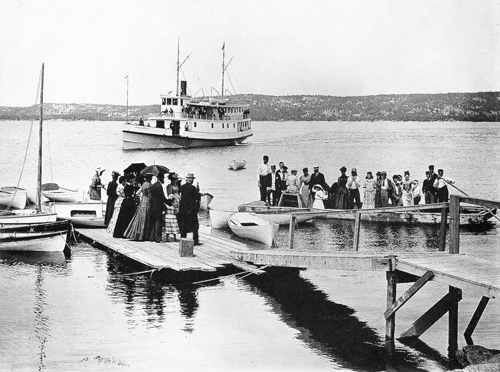B A C K T H E N
The Bath Built Steamer, Juliette

1892. Little Deer Isle. The new Bath-built steamer Juliette, owned by the redoubtable Captain Oscar Crockett, pauses to take on passengers who are being sculled out from the flag landing at the “Egge-moggin” cottage colony. The following year the unwieldy scow was replaced by a seineboat.
Penobscot Bay, with its many island and mainland fishing, farming, quarrying, and resort commu-nities, was ripe territory for steamboats. Today we have difficulty comprehending the geographical realities of the coast before the automobile; travel between Rockland and Little Deer Isle today is by land via two large suspension bridges. A century ago, while it was possible to make the journey by land, no sane person would have done so, as most of the trip would have been spent bouncing along in vari-ous stages, sometimes going in the wrong direction. The fastest, most convenient, most comfortable, and cheapest way to make the trip, by far, was by water, aboard a steamer.
A steamer flag landing was like a railroad flag stop; to make certain that the steamer would call, a flag was hoisted. The responsibility for building landing facilities rested with the local powers that be, in this case, the keeper of the nearby Pumpkin Island Light, a Civil War veteran named Captain Charles Babson who had developed the cottage colony. Babson’s float was sufficient for tying up his livery boats, but not a steamer. An approaching steamer with a passenger to discharge blew its whistle to signal for a rowboat to come out. Often the rower would be Babson’s daughter. Disembarking passengers would climb down a ladder hung over the side, treating the whole episode as an adventure, rather than as an opportunity for a lawsuit.
Travel between Little Deer Isle and Deer Isle proper was by rowboat at high water, or by high-wheeled wagon at low water. A sailing-scow ferry operated across the Reach between Deer Isle and Sargentville, where a stageline connected to Blue Hill. Deer Isle itself had two steamer landings.
Due to a ledge, steamers approached the Eggemoggin landing from the same direction whether westbound or eastbound, so we can’t tell which way the Juliette is headed. The folks in the scow are gathered in two distinct groups. Those in the bow appear to be sober-acting summer people, while a light-hearted group of local-looking young people skylark aft. One young man is cross-hatting, and a cheeky young women flirts with the photographer. Little baggage is in evidence, so both groups may be on outings, a common practice. The spectators gathered on the hastily assembled float—its planks still need trimming—may be just that, as it didn’t take much excitement to draw a crowd.
Captain Oscar Crockett was a living legend, and his Rockland-to-Ellsworth “Blue Hill Line,” an important institution. Beginning the run in 1881 with the ancient side-wheeler Henry Morrison—of which it was said that the only way they could have made her homelier was to have made her larger—he hit his stride with the1892 Juliette and her running mate, the 1893 Catherine. Both were maintained like yachts. Exceptionally well built, their hulls were heavily braced against “hogging,” or drooping. Twice each year all hands turned-to to tighten the hogging frame bolts, and the sisters never lost their youthful sheerlines.
Both steamers were sponsoned—a protruding sponson shows well here—to provide a wide freight deck; express freight was an important part of business. Cultivating good will was also important, and close inspection shows the pilothouse to be filled with privileged passengers. This was a common, if risky, custom; the famous Gov. Bodwell was said to have come to grief on a Swan’s Island ledge after following the advice of a know-it-all.
Babson’s locally built rowboats were inexpensive and looked it, but they rowed well and provided many a young summer visitor with the thrill of first command. The pleasure that a millionaire received from a hundred-foot yacht was but a fraction of that enjoyed by a ten year old turned loose in a rowboat. These boats were later sold to cottagers—as a family member, the boat with the high seatback became the Ethel. The little catboat was built by the Eatons at Castine. The resort business gave a great boost to wintertime boatbuilding.
Text by William H. Bunting from A Days Work, Part 1, A Sampler of Historic Maine Photographs, 1860–1920, Part II. Published by Tilbury House Publishers, 12 Starr St., Thomaston, Maine. 800-582-1899.
